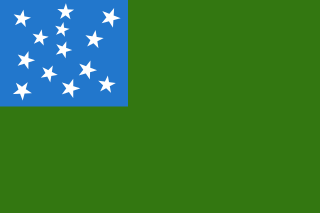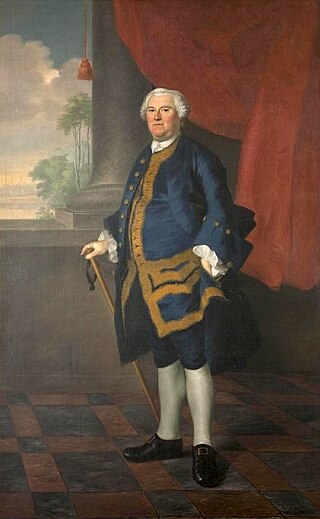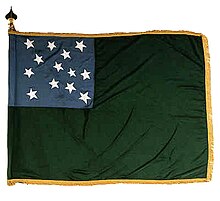
Ethan Allen was an American farmer, writer, military officer and politician. He is best known as one of the founders of Vermont and for the capture of Fort Ticonderoga during the American Revolutionary War, and was also the brother of Ira Allen and the father of Fanny Allen.

The Green Mountain Boys were a militia organization established in 1770 in the territory between the British provinces of New York and New Hampshire, known as the New Hampshire Grants and later in 1777 as the Vermont Republic. Headed by Ethan Allen and members of his extended family, it was instrumental in resisting New York's attempts to control the territory, over which it had won de jure control in a territorial dispute with New Hampshire.

Dorset is a town in Bennington County, Vermont, United States. The population was 2,133 at the 2020 census. Dorset is famous for being the location of Cephas Kent's Inn, where four meetings of the Convention that signed the Dorset Accords led to the independent Vermont Republic and future statehood. Dorset is the site of America's oldest marble quarry and is the birthplace of Bill W., co-founder of Alcoholics Anonymous. East Dorset is the site of the Wilson House and the Griffith Library. The town is named after the English county of Dorset.

Westford is a town in Chittenden County, Vermont, United States. The population was 2,062 at the 2020 census.

Benning Wentworth was an American merchant, landowner and colonial administrator who served as the governor of New Hampshire from 1741 to 1766. He is best known for issuing several land grants in territories claimed by the Province of New Hampshire west of the Connecticut River while serving as governor, which led to disputes with the neighboring Province of New York and the eventual establishment of Vermont.

Thomas Chittenden was an American politician from Vermont, who was a leader of the territory for nearly two decades. He was the state's first and third governor, serving from 1778 to 1789—when it was a largely unrecognized independent state called the Vermont Republic—and again from 1790 until his death. Vermont was admitted to the Union in 1791 as its 14th state.

The Province of New Hampshire was an English colony and later a British province in New England. It corresponds to the territory between the Merrimack and Piscataqua rivers on the eastern coast of North America. It was named after the English county of Hampshire in southern England by Captain John Mason in 1629, its first named proprietor. In 1776, the province established an independent state and government, the State of New Hampshire, and joined with twelve other colonies to form the United States.

The Province of Maine refers to any of the various English colonies established in the 17th century along the northeast coast of North America, within portions of the present-day U.S. states of Maine, New Hampshire, and Vermont, and the Canadian provinces of Quebec and New Brunswick. It existed through a series of land patents made by the kings of England during this era, and included New Somersetshire, Lygonia, and Falmouth. The province was incorporated into the Massachusetts Bay Colony during the 1650s, beginning with the formation of York County, Massachusetts, which extended from the Piscataqua River to just east of the mouth of the Presumpscot River in Casco Bay. Eventually, its territory grew to encompass nearly all of present-day Maine.

The Vermont Republic officially known at the time as the State of Vermont, was an independent state in New England that existed from January 15, 1777, to March 4, 1791. The state was founded in January 1777, when delegates from 28 towns met and declared independence from the jurisdictions and land claims of the British colonies of Quebec, New Hampshire, and New York. The republic remained in existence for the next fourteen years, albeit without diplomatic recognition from any foreign power. On March 4, 1791, it was admitted into the United States as the State of Vermont, with the constitution and laws of the independent state continuing in effect after admission.

Seth Warner was an American soldier. He was a Revolutionary War officer from Vermont who rose to the rank of Continental colonel and was often given the duties of a brigade commander. He is best known for his leadership in the capture of Fort Crown Point, the Battle of Longueuil, the siege of Quebec, the retreat from Canada, and the battles of Hubbardton and Bennington.

The geologic history of Vermont begins more than 450 million years ago during the Cambrian and Devonian periods.
New Hampshire is a state in the New England region of the northeastern United States. During the American Revolution, it was one of the Thirteen Colonies that revolted against British rule. One of the smallest U.S. states in area and population, it was part of New England's textile economy between the American Civil War and World War II. Since the 20th century, the state has been known for its presidential primary, outdoor recreation, its educational boarding schools, and being part of the biotech industry.

The northern boundary of Massachusetts adjoins two other states: Vermont and New Hampshire. The majority of the boundary is roughly a straight line from the northwest corner of the state east to a point in Dracut, just north of Lowell. East of that point, the border is a series of line segments about 3 miles (5 km) north of the curving Merrimack River, ending in the Atlantic Ocean.

The Old Constitution House is a historic house at 16 North Main Street in Windsor, Vermont. It is the birthplace of the Vermont Republic and the Constitution of the State of Vermont. A mid-18th century building built in a simple Georgian architectural style, the Old Constitution House was originally called the Windsor Tavern, and belonged to Elijah West at the time of the signing of the constitution. The house is a Vermont State Historic Site, and is administered by the Vermont Division for Historic Preservation. It is also listed on National Register of Historic Places, separately since March 11, 1971 as well as a part of the Windsor Village Historic District since April 23, 1975.

The Haldimand Affair was a series of negotiations conducted in the early 1780s between Frederick Haldimand, the British governor of the Province of Quebec, his agents, and several people representing the independent Vermont Republic.
Admission to the Union is provided by the Admissions Clause of the United States Constitution in Article IV, Section 3, Clause 1, which authorizes the United States Congress to admit new states into the Union beyond the thirteen states that already existed when the Constitution came into effect. The Constitution went into effect on June 21, 1788, in the nine states that had ratified it, and the U.S. federal government began operations under it on March 4, 1789, when it was in effect in 11 out of the 13 states. Since then, 37 states have been admitted into the Union. Each new state has been admitted on an equal footing with those already in existence.
Property Law in New York during the 17th Century colonial period was based upon manorialism. Manorialism was characterized by the vesting of legal and economic power in a Lord of the Manor, supported economically from his own direct landholding in a manor and from the obligatory contributions of a legally subject population of tenants and laborers under the jurisdiction of his manorial court. These obligations could be payable in several ways, in labor, in kind, or, on rare occasions, in coin.
Jonas Fay was a military and political leader of Vermont during its period as an independent republic, and during the early years of its statehood. Born in Massachusetts, he served in the militia during the French and Indian War, studied medicine, and became a physician. His father moved to Vermont during its formative years, and Jonas Fay moved with him. Fay was active in the Green Mountain Boys and their resistance to New York's efforts to assume jurisdiction over Vermont. In 1775, he served as a physician for the contingent of Green Mountain Boys that captured Fort Ticonderoga.
Jacob Bayley was an officer, first serving with the British in the French and Indian War, then later as a brigadier general in the Continental Army during the American Revolutionary War.















